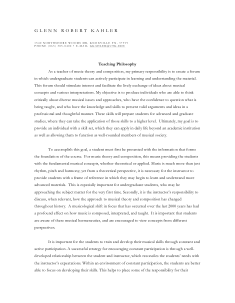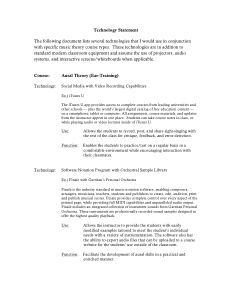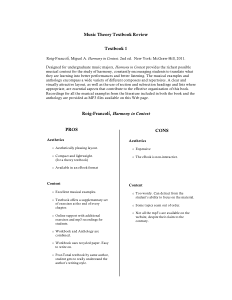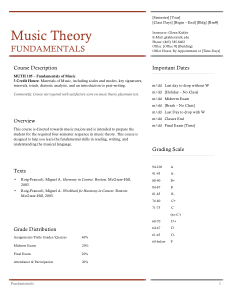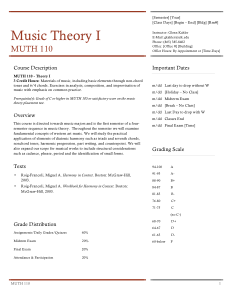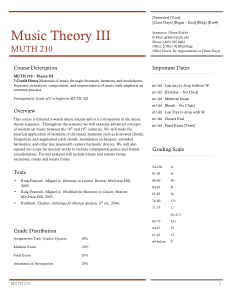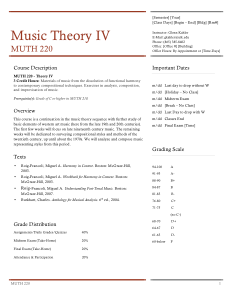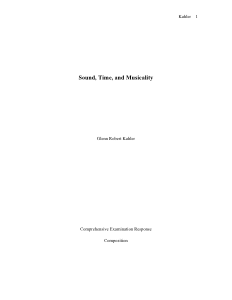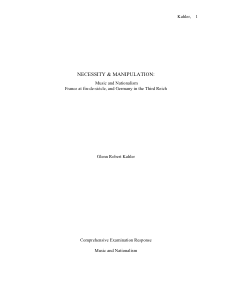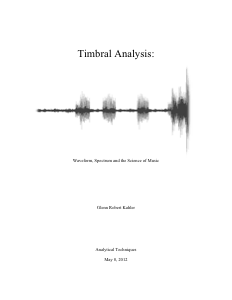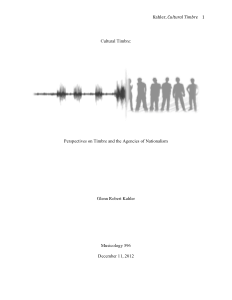Glenn Robert Kahler
Academia
The following document summarizes the philosophies I use when teaching music.
Teaching Philosophy
The following document lists several technologies that I would use in conjunction with specific music theory course types. These technologies are in addition to
standard modern classroom equipment and assume the use of projectors, audio systems, and interactive screens/whiteboards when applicable.
Technology Statement
The following document is a sample of curriculum I feel comfortable teaching. It lists a typical degree-seeking undergraduate sequence in music theory and ear training. The document features basic information, credits and a description for each course in the sequence. The document begins with a table of music theory courses, assorted by year and semester, required of all music majors including those majoring in theory/composition. Next, the document features the Core Curriculum for all undergraduate music degree programs, followed by additional music theory courses required for theory/composition majors, less applied composition lessons, or independent study.
Sample Curriculum
This document is a sample review of two standard undergraduate music theory textbooks. Each text was examined thoroughly and reduced to a succinct list of pros and cons.
Sample Textbook Review
The following documents are sample course syllabi I use for teaching for an undergraduate written music theory sequence.
Overview:
This course is directed towards music majors and is intended to prepare the student for the required four-semester sequence in music theory. This course is
designed to help you learn the fundamental skills in reading, writing, and understanding the musical language.
Sample Syllabi: Music Fundamentals
Overview:
This course is directed towards music majors and is the first semester of a four-semester sequence in music theory. Throughout the semester we will examine fundamental concepts of western art music. We will study the practical application of elements of diatonic harmony such as triads and seventh chords, non-chord tones, harmonic progression, part writing, and counterpoint. We will also expand our scope for musical works to include structural considerations such as cadence, phrase, period and the identification of small forms.
Sample Syllabi: Music Theory I
Overview:
This course is directed towards music majors and is a continuation in the music theory sequence. The course will review species counterpoint in the opening weeks, and then turn to study of topics including 2nd inversion chords, dominant 7th chords, secondary functions, and modulations. We will also consider concepts such as harmonic rhythm, figured bass and harmonizing a melody.
Sample Syllabi: Music Theory II
Overview:
This course is directed towards music majors and is a continuation in the music theory sequence. Throughout the semester we will examine advanced concepts
of western art music between the 18th and 19th centuries. We will study the practical application of elements of chromatic harmony such as borrowed chords, Neapolitan and augmented sixth chords, modulation techniques, extended harmonies, and other late nineteenth century harmonic devices. We will also
expand our scope for musical works to include contrapuntal genres and formal considerations. Formal analyses will include binary and ternary forms, variations, rondo and sonata forms.
Sample Syllabi: Music Theory III
Overview:
This course is a continuation in the music theory sequence with further study of basic elements of western art music (here from the late 19th and 20th centuries).
The first few weeks will focus on late nineteenth century music. The remaining weeks will be dedicated to surveying compositional styles and methods of the
twentieth century, up until about the 1970s. We will analyze and compose music representing styles from this period.
Sample Syllabi: Music Theory IV
My response to a graduate comprehensive examination question posed to me by my advisor Dr. Kenneth Jacobs.
The following document presents a narrative of the basic concepts of the following texts.
New Musical Resources by Henry Cowell
The Craft of Musical Composition by Paul Hindemith
The Schillinger System of Musical Composition by Joseph Schillinger
The Technique of My Musical Language by Olivier Messiaen
Genesis of a Music, by Harry Partch
Writing Sample: Sound, Time, and Musicality
My response to a graduate comprehensive examination question posed to me musicologist by Dr. Jacqueline Avila.
Through the course of our nationalism seminar, we examined the musical practices of several countries and attempted to tease out nationalist paradigms and
principles in their respective musical traditions. The following is a discussion of several ways music has been used for a nationalist cause, and how a particular
music can come to define a country. This paper will examine the ways in which music was used in two countries that were each torn apart by war and depression: France at fin-de-siècle, and Germany in the Third Reich.
Writing Sample: Necessity and Manipulation
The following is in one part, a study of several scientific aspects of music, namely waveform and instrumental spectrum, and in another part a detailed look into the
monophonic instrumental spectrum of the flute and its relation to solo flute repertoire. Notwithstanding, this paper however is primarily a proposal for the
development of a system of timbral analysis based on spectrum, waveform, and acoustic properties inherent of in the harmonic series and its relation to the characteristic, instruments, instrumental combinations, and music.
Writing Sample: Timbral Analysis
The following is a proposed extension to the Kahler System of Timbral Analysis intended to facilitate a musicological approach to timbre and culture. While general statements certainly can be made about a particular cultures’ aural preference for certain timbres (i.e. instruments or combinations thereof) the ability to express these tendencies in quantifiable terms has remained vague. The purpose of this study is to compare
similar instruments to reveal cultural predilections for certain timbres, and identify possible patterns that may reflect national identity.
Writing Sample: Cultural Timbre
Unless otherwise noted, all content (images, writings, music, and scores) is copyrighted by Glenn Robert Kahler © 2013 all rights reserved.
The following documents relate to my experience with teaching music and academic writing samples.
